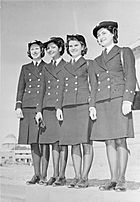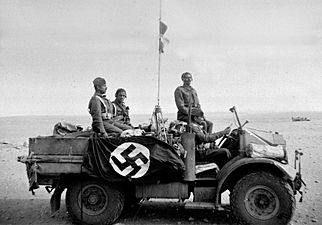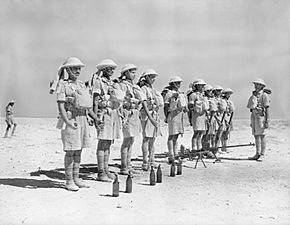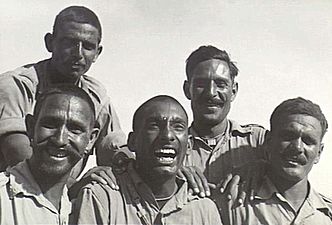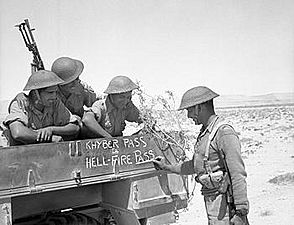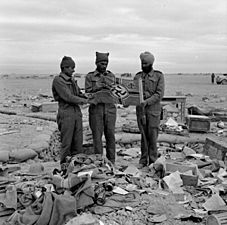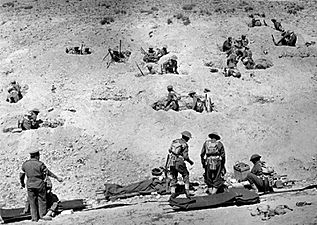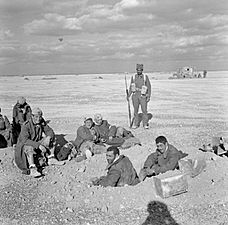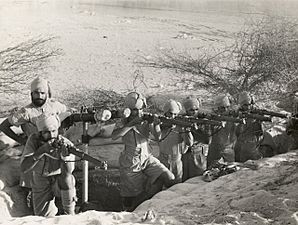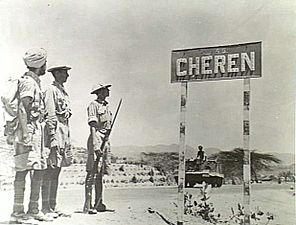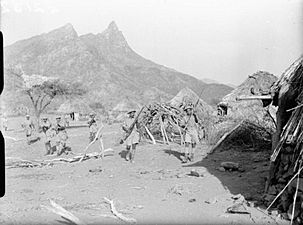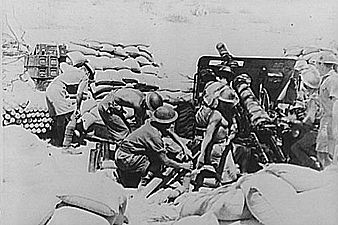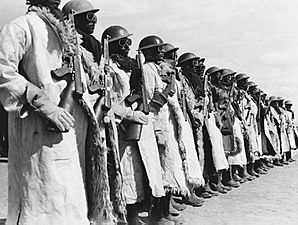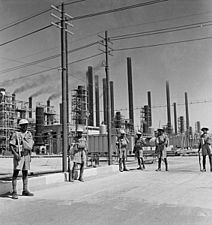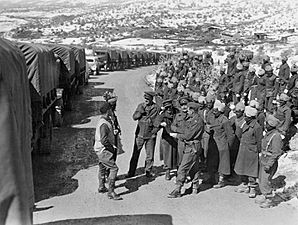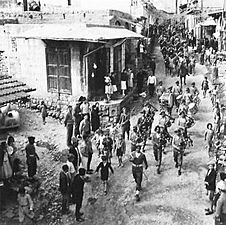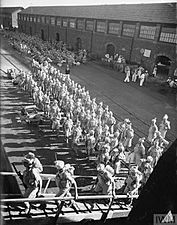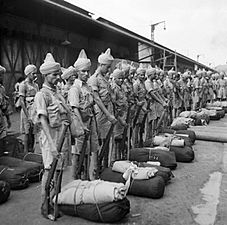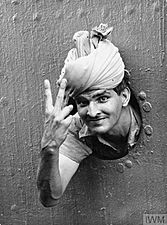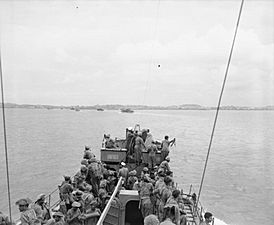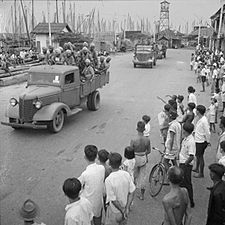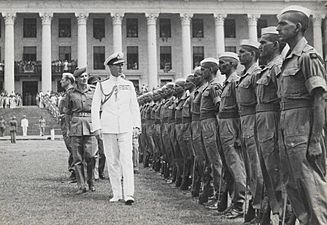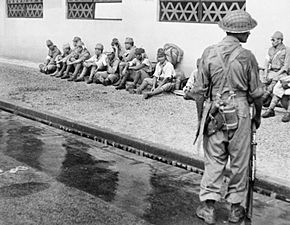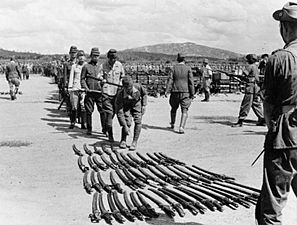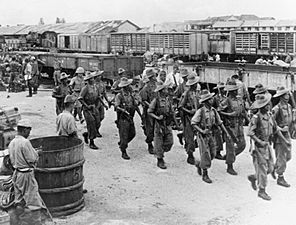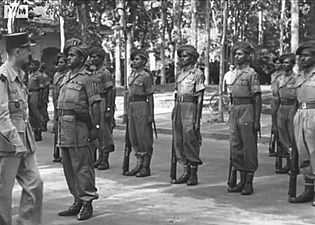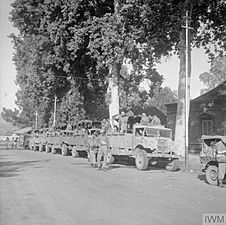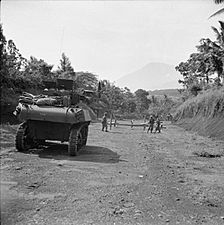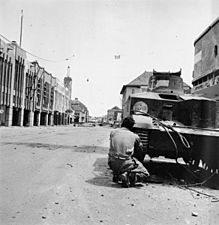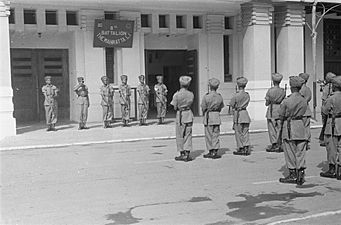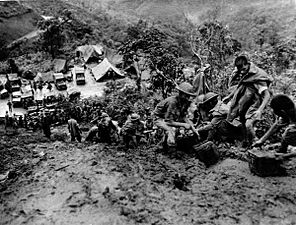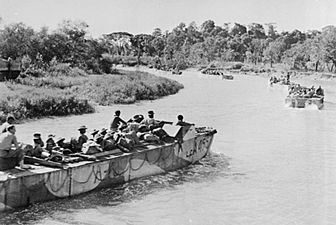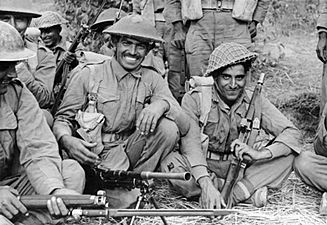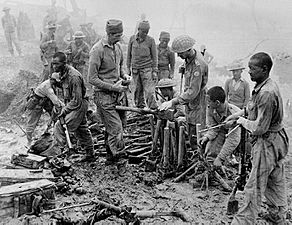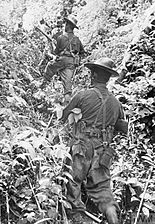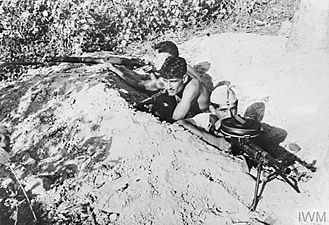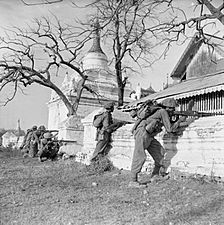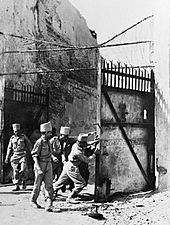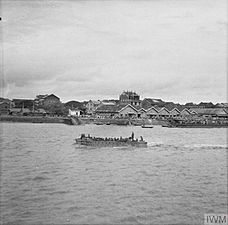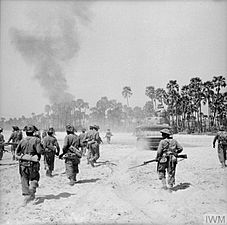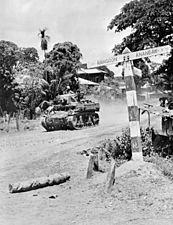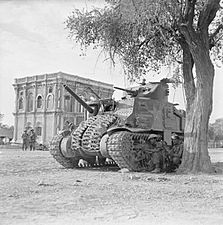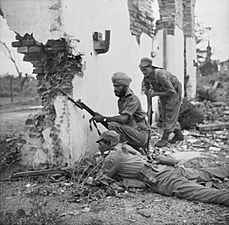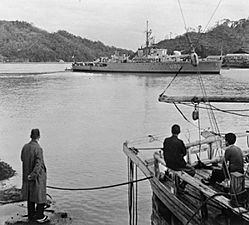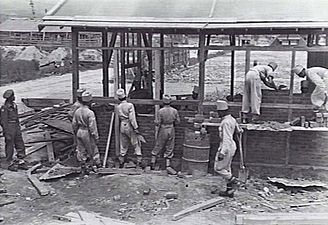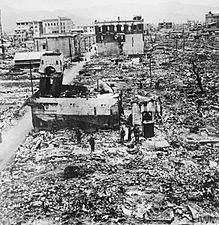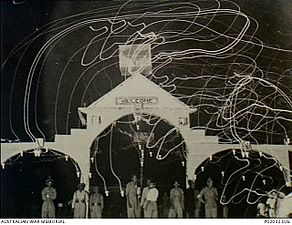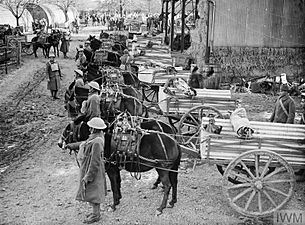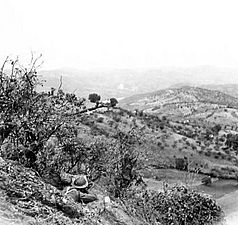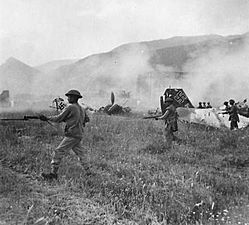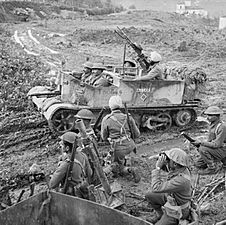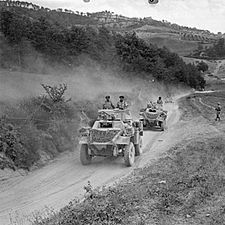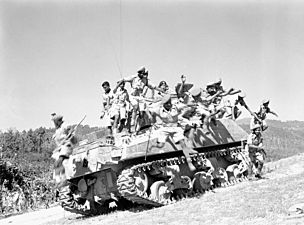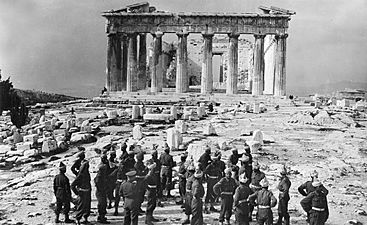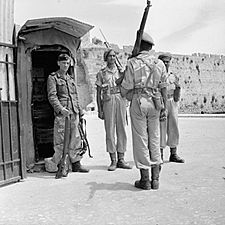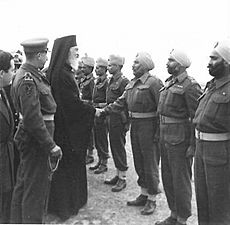Indian Army during World War II facts for kids
Quick facts for kids Indian Army |
|
|---|---|
 
New Indian Army recruits
|
|
| Active | 1895–1947 |
| Country | |
| Allegiance | |
| Type | Army |
| Size | 2.5 million men |
| Garrison/HQ | GHQ India (Delhi) |
| Commanders | |
| Notable commanders |
Archibald Wavell, 1st Earl Wavell Claude Auchinleck |
The Indian Army during World War II was a huge force that played a vital role in the Second World War. When the war started in 1939, it had about 200,000 soldiers. But by August 1945, it had grown to over 2.5 million men. This made it the largest volunteer army in history!
These brave soldiers fought on three different continents: Africa, Europe, and Asia. They served in different types of units, including infantry (foot soldiers), armoured (tanks), and even a new airborne (paratrooper) force.
The Indian Army fought against the Italian Army in Ethiopia. They also battled both Italian and German armies in places like Egypt, Libya, Tunisia, and Algeria. After Italy surrendered, they continued fighting the German Army in Italy.
However, most of the Indian Army fought against the Japanese Army. First, they faced tough defeats in Malaya and had to retreat from Burma to India. Later, after getting stronger and re-equipping, they bravely advanced back into Burma. This was part of the largest British Empire army ever put together.
These battles were very costly. Over 87,000 Indian soldiers lost their lives. Another 34,354 were wounded, and 67,340 became prisoners of war. Their courage was recognized with about 4,000 awards. Eighteen members of the Indian Army received the Victoria Cross or the George Cross, which are very high awards for bravery.
Field Marshal Claude Auchinleck, who led the Indian Army from 1942, said that the British "couldn't have come through both wars" (World War I and II) without the Indian Army. British Prime Minister Winston Churchill also praised "The unsurpassed bravery of Indian soldiers and officers."
Contents
How the Army Grew
In 1939, the Indian Army was an experienced British force. It had fought in several conflicts before World War II. There were plenty of people willing to join, but the army needed more skilled technical workers. They were also just starting to change their cavalry (horse-riding) units into tank forces, but they didn't have enough tanks.
At the start of the war, British officials didn't plan to make the Indian Army much bigger. It had about 130,000 men. Their main jobs were to keep peace inside India and defend against a possible threat from Russia. But as the war continued, the Indian Army grew very quickly. Soldiers were sent to battlefronts as soon as they could be. The biggest problem was not having enough equipment.
Army Organization
The Indian Army in 1939 was different from how it was in World War I. It had been reorganized in 1922. The army had fewer cavalry regiments and infantry battalions. It also started to modernize, getting its own artillery units. By 1936, the Indian Army had promised to send troops to places like Singapore, the Persian Gulf, and Egypt if war broke out.
By 1939, the army had about 194,373 men. They could also call on other forces, like the Frontier Irregular Force and the Indian State forces. These added many more soldiers.
There were 22 regular cavalry regiments, which provided tank and armoured car units. They also had 20 regular Indian infantry regiments and 10 Gurkha regiments. During the war, many more battalions were added to these regiments.
The Indian Army was not ready for World War II. It didn't expect to be involved in fighting. The British government even said it probably wouldn't be needed. So, it was a surprise when two infantry divisions were asked to fight in North Africa and East Africa. Four mule companies were even sent to France!
New Divisions Formed
In May 1940, Britain and India agreed to create five more infantry divisions and one armoured division. These new divisions were meant to defend Malaya and Iraq. An armoured brigade was sent to Egypt, but forming the rest of the armoured division was delayed because of a lack of armoured vehicles.
By March 1941, the Indian government changed its defense plan. They were worried about Japan and needed to replace the divisions sent overseas. So, seven new armoured regiments and 50 new infantry battalions were formed. This led to five new infantry divisions and two armoured formations.
In 1942, about 40,000 Indian soldiers were captured when Singapore fell. Many of them (30,000) joined the Indian National Army. Those who refused became prisoners of war and were often sent to New Guinea.
Since most divisions were fighting overseas in 1942, the army formed four more infantry divisions and another armoured division. One of these, the 36th Division, was special because it was made up of British brigades that came from Madagascar and Britain.
After some tough battles in Malaya and Burma in 1942, it was decided that the infantry divisions had too many machines. So, some divisions were made "light," meaning they had fewer machines and relied more on animals and four-wheel-drive vehicles.
By December 1942, India was chosen as the main base for attacking operations. The plan was to support 34 divisions, including British, African, and Indian divisions.
In 1943, another infantry division, an airborne division, and a heavy armoured brigade were planned. Only the 44th Indian Armoured Division was formed by combining two existing armoured divisions. Infantry divisions also received two extra infantry battalions.
A committee in 1943 suggested ways to improve the army. They recommended:
- Better training for officers and soldiers.
- Increasing basic training to nine months, plus two months of jungle training.
- Improving the system for sending replacement soldiers.
- Making infantry brigades include one British, one Indian, and one Gurkha battalion.
To help with jungle training, two divisions (14th and 39th) became training divisions from July 1943. Battalions would spend months learning jungle warfare before going to the front lines.
In 1944, the planned 44th Indian Airborne Division was finally formed. Infantry divisions were also changed again to have three infantry brigades plus three extra infantry battalions.
Training for jungle warfare became very successful. From May 1944, special brigades trained units for the Fourteenth Army and other forces.
Infantry Divisions
Infantry divisions usually had three infantry brigades, each with three infantry battalions. Often, one battalion in each brigade was British, and two were Indian or Gurkha. Later in the war, as fewer British soldiers were available, Indian units replaced them in Burma.
A typical division had a reconnaissance unit (for scouting), a machine gun battalion, and artillery. The artillery included field guns, anti-tank guns, and anti-aircraft guns. There were also engineer, medical, and transport units.
Some divisions were different depending on their role. "Light" divisions had fewer heavy machines and used mules and Jeeps for transport. "Animal and Mechanised Transport" (A & MT) divisions used a mix of animals and vehicles.
Armoured Divisions
India planned to form armoured divisions, but they often lacked equipment like tanks. The 31st Armoured Division, for example, had to change its organization several times due to tank shortages.
By March 1944, the armoured force was reduced to one division (the 31st Armoured Division in the Middle East) and three independent tank brigades fighting in Burma.
Airborne Troops
The 50th Independent Indian Parachute Brigade was formed in October 1941. It included British, Indian, and Gurkha parachute battalions. This brigade fought bravely in the Battle of Sangshak in March 1944.
The 44th Indian Armoured Division was changed into the 44th Airborne Division in April 1944. This division included parachute brigades and airlanding brigades (troops who land by glider).
Artillery and Engineers
While some artillery still came from the British Royal Artillery, the Indian Regiment of Artillery was formed in 1935. It grew a lot during the war, forming many field, mountain, anti-tank, and anti-aircraft artillery regiments. In 1945, it was given the title Royal Indian Artillery.
The Indian Engineers were part of every division. They started the war with a few companies but expanded greatly, forming many field companies and squadrons.
Women's Auxiliary Corps (India)
The Women's Auxiliary Corps (India), or WAC(I), was formed in May 1942. Women aged 18 and older could join for clerical or domestic duties. By the end of the war, 11,500 women had joined. They could serve anywhere in India.
Recruitment was sometimes difficult due to social customs. Many members came from the mixed-race Anglo-Indian community. The WAC(I) had an Air Wing for duties at airfields. Later, a Naval Wing became the Women's Royal Indian Naval Service (WRINS) in 1944.
Indian States Forces
The armies of the Indian States (also known as Princely States) provided another 250,000 men during the war. They contributed cavalry and infantry units. One of their soldiers, Captain Mahmood Khan Durrani, received the George Cross while held captive by the Japanese.
Chindits
The Chindits were special units that went on long-range raids behind enemy lines in Burma. They were created by Brigadier Orde Wingate. Their goal was to fight the Japanese by attacking them from behind. In 1943, they launched Operation Longcloth.
In 1944, they did a much bigger operation. The Chindits were regular infantry units chosen for these missions. They were disbanded in February 1945. Many of their veterans later joined the 44th Airborne Division.
Recruitment
In October 1939, the Indian Army had about 205,038 men. At first, not many new soldiers were recruited because Britain didn't expect India to be a big part of a European war. But after France fell in 1940, London quickly asked for the Indian Army to grow fast.
The army doubled to 456,000 by the end of 1940 and reached over 1.5 million by the end of 1942. It peaked at 2.25 million men. This was an amazing growth, achieved only by volunteers, not by forcing people to join.
However, the British preferred recruiting from certain groups they called "martial races." By mid-1942, these groups were not volunteering as much due to other opportunities. So, the army started recruiting from other areas, like Madras, where people joined more for economic reasons due to rising prices. Even so, the "martial races" still made up most of the frontline soldiers by 1945.
Where They Fought
The Indian Army sent its units to fight in many different armies under the British Empire.
Eighth Army
The Eighth Army was formed in September 1941. It fought in North Africa and was led by famous generals like Bernard Montgomery. After some early struggles, it made a big advance across Libya and Tunisia.
Fourteenth Army
The Fourteenth Army was a large force with soldiers from many Commonwealth countries, including many from the Indian Army. It was often called the "Forgotten Army" because its battles in Burma were not widely reported.
Formed in 1943 under Lieutenant General William Slim, it became the largest Commonwealth Army during the war, with nearly a million men by late 1944. It played a huge role in defeating the Japanese in Burma.
Battles in the Middle East and Africa
North Africa
Just before the war, Indian infantry brigades were sent to Egypt. By March 1940, two Indian divisions were in Egypt.
Operation Compass (with the 4th Indian Division) was the first major Allied operation in North Africa. It was a huge success, pushing across Libya and capturing many Italian soldiers and equipment.
When German forces arrived, led by Erwin Rommel, they attacked in March 1941. The 3rd Indian Motor Brigade fought a delaying battle that helped Australian troops withdraw safely.
Later, the 4th and 10th Indian Divisions fought in key battles like the Battle of Gazala and the First Battle of El Alamein, helping to hold the line against Axis forces. The 4th Indian Division also took part in the Second Battle of El Alamein, a major turning point.
-
Central Indian Horse after taking back Benghazi
-
Indian soldiers smile at Tobruk
-
From Khyber Pass to Hellfire Pass, Operation Battleaxe
-
Indian troops man anti-aircraft Bren gun, Western Desert
East Africa
In August 1940, Italian forces attacked British Somaliland. Indian troops were involved in the fighting and later evacuated.
In December 1940, the 4th and 5th Indian Infantry Divisions were sent to Sudan. From February to April 1941, they took part in the Battle of Keren. By the end of this campaign, Italian forces were cleared from Eritrea and Ethiopia, and 220,000 Italian soldiers became prisoners.
Iraq and Persia
In 1941, Indian forces were needed in Iraq to protect supply routes to the Soviet Union. The 8th Indian Infantry Division landed at Basra and helped secure Iraq from pro-German forces.
Later, in August 1941, the 8th and 10th Indian Infantry Divisions invaded southern Persia (Iran) to protect oil fields from the advancing German Army. This invasion was quick and successful.
-
Indian troops in winter clothing in Persia
-
Indian camouflage unit with dummy Stuart tank in Baghdad
-
Indian soldiers guard Anglo-Iranian Oil Company refinery at Abadan
-
Indian soldiers stand next to supply convoy en route to Soviet Union
Syria and Lebanon
The Indian Army's 5th Brigade (from the 4th Indian Infantry Division) and the 10th Indian Infantry Division attacked Syria from different directions in June and July 1941. They took part in battles like the Battle of Damascus and the Battle of Deir ez-Zor.
-
Indian tank passes wrecked Vichy French tank on road to Damascus
Battles in South-East Asia
Hong Kong
The Japanese Army attacked Hong Kong on December 8, 1941. Indian Army troops, including the 5/7th Rajput Regiment and the 2/14th Punjab Regiment, were part of the defenders. The garrison fought for 18 days before surrendering.
Malaya and Singapore
Before the war, the Indian Army sent an infantry brigade to Malaya. By 1941, forces in Malaya were not well-equipped for jungle warfare.
On December 8, the Japanese Army invaded Malaya. Indian divisions, including the 9th and 11th Indian Infantry Divisions, fought bravely. Battles like the Battle of Jitra and the Battle of Slim River were very tough. In the Battle of Muar, one brigade lost most of its men.
The Battle of Singapore ended on February 15, 1942, with the capture of 55,000 Indian servicemen. Many became prisoners of war.
Borneo
In late 1940, the 2nd Battalion, 15th Punjab Regiment, was sent to Kuching, Sarawak. They fought bravely against the Japanese invasion in December 1941. Many were killed or captured. The remaining soldiers continued to resist in the jungle until April 1942. Their resistance was praised as a great feat of endurance.
Return to Malaya and Singapore
In January 1945, the 25th Indian Infantry Division took part in the first large-scale amphibious operations in Southeast Asia. They landed on Akyab Island and later occupied other areas. In April 1945, they prepared for Operation Zipper, the invasion of Malaya. Even though the war ended, the operation went ahead, and the 23rd and 25th Divisions were the first to land in Malaya in September, accepting the Japanese surrender.
The 5th Indian Infantry Division also sailed to Singapore in August 1945. They arrived on September 4, and Japanese forces in Singapore officially surrendered on September 12.
-
Indian landing craft enter bay at Singapore
-
Japanese officers surrender swords to 25th Division in Kuala Lumpur
After Japanese Surrender
After the Japanese surrender, some Indian divisions were sent to disarm the Japanese and help local governments. The 7th Division went to Thailand, the 20th Division to French Indochina (Vietnam), and the 23rd Division to Java (Indonesia). In these places, they sometimes faced local independence movements.
-
7th Division supervise disarmament of Japanese prisoners in Bangkok
-
General Leclerc reviews troops of 20th Division in Saigon
-
Indian troops on road to Bangjoebiroe Camp to free Dutch civilians held by Indonesian Nationalists
-
26th Division mortar positions outside Medan, Sumatra
-
6/5th Mahratta Light Infantry in Jakarta, Java
Burma Campaign
In 1941, two Indian infantry brigades were sent to reinforce Burma. On December 8, the Japanese Army invaded Burma. British and Indian forces had to retreat to India by July 1942.
Japanese Conquest of Burma
The Battle of Bilin River in February 1942 was fought by the 17th Indian Infantry Division. They held the Japanese for two days but had to retreat. The Battle of Sittang Bridge followed, where the 17th Division lost most of its heavy equipment. The fighting retreat to India was completed in May, just before the monsoon season.
About 12,000 Indian prisoners of war captured in Malaya or Singapore joined the First Indian National Army.
Burma Campaign 1943
The Arakan Campaign in 1942–43 was not successful. British and Indian soldiers were not properly trained for jungle fighting, which affected their morale. There were also problems with supplies and leadership.
Burma Campaign 1944
The Battle of the Admin Box in February 1944 was a major victory. Japanese forces tried to attack the 7th Division's headquarters. But the Allied soldiers held their ground, supported by tanks. This was the first time in the Burma Campaign that Japanese tactics were defeated.
The Battle of Imphal and the Battle of Sangshak (March-July 1944) took place in North-East India. The Japanese Army and the Indian National Army tried to invade India but were pushed back with heavy losses.
The Battle of Kohima was a turning point. The Japanese tried to capture Kohima ridge, which was vital for supplying Allied troops. British and Indian reinforcements counter-attacked and drove the Japanese away. The battle ended in June when the road was reopened.
-
Gurkhas advance with Lee tanks on Imphal-Kohima road
Burma Campaign 1945
The Battle of Meiktila and Mandalay (January-March 1945) were decisive battles. Allied forces, including many Indian divisions and tank brigades, used their tanks and air power to destroy most of the Japanese forces in Burma. This allowed the Allies to recapture the capital, Rangoon, and most of the country.
The Battle of Ramree Island (January-February 1945) was fought to capture an island off the Burma coast. The goal was to build airbases there.
Operation Dracula was an airborne and amphibious attack on Rangoon. When it was launched, the Japanese Army had already left the city.
-
44th Airborne Division parachute to drop zone south of Rangoon
-
Indian troops take cover behind Lee tank during street fighting in Mandalay
Japan
British Commonwealth Occupation Force
Indian Army units were part of the British Commonwealth Occupation Force (BCOF) in Japan after the war. This force helped disarm Japan and oversee its industries. They were responsible for occupying several prefectures and Shikoku Island.
-
HMIS Sutlej at Kōchi, Shikoku Island, Japan
-
Indian soldiers survey ruins of Hiroshima
-
Indian troops celebrate India's Independence at BCOF base in Bofu, Japan
Europe
France
In 1940, four mule companies from the British Indian Army Service Corps were sent to France. They were evacuated from Dunkirk with other British forces in May 1940.
-
British Indian Army Service Corps on parade in France
Italy
Allied forces landed in Italy on September 9, 1943. The 4th, 8th, and 10th Indian Divisions, along with the 43rd Independent Gurkha Infantry Brigade, were all involved.
In October 1943, the 8th Indian Division helped break through the German Barbara Line. The 8th Division also led the attack on the Bernhardt Line and crossed the Sangro River.
The 4th Indian Division took part in the Battle of Monte Cassino. In the final battle there, the 4th British Division and 8th Indian Infantry Division made difficult crossings of the Rapido River.
The Gothic Line was Germany's last major defense line in Italy. Indian divisions helped break through it in August 1944. In the 1945 spring offensive, the 8th Indian Division played a crucial role in crossing the Senio River. Hostilities in Italy officially ended on May 2, 1945.
-
Indian soldier holds captured swastika flag after surrender of German forces in Italy
-
Indian soldier escorts German prisoners after Battle of the Sangro
-
5th Mahratta Light Infantry train in Florence
Greece
On October 24, 1944, the 4th Indian Infantry Division was sent to Greece. Their job was to help stabilize the country after the Germans left. They were spread out to watch borders and garrison towns.
In December, a general strike was declared, and police opened fire on protesters. A truce was made in Athens on January 15, which ended most fighting.
-
Indian Universal Carrier crew play with children in Cyprus
-
Indian soldiers sweep for mines after landing in Salonika
-
Bhopal Regiment take over German sentry position after liberation of Rhodes
Awards for Bravery
Indian soldiers received 4,000 awards for their bravery. Thirty-one of these were the Victoria Cross, the highest military award for courage "in the face of the enemy."
The George Cross is another high award for bravery, given for actions not directly against the enemy. Several Indian Army members also received the George Cross.
After the War
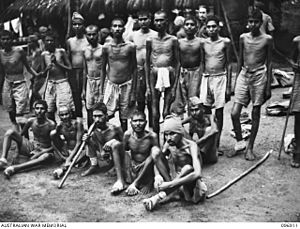
World War II caused the deaths of over 87,000 soldiers, air crews, and sailors from the Indian Empire. This included 24,338 killed and 11,754 missing. Another 34,354 were wounded.
Out of nearly 80,000 Indian prisoners of war (POWs), about 15,000-17,000 were held by German or Italian forces. Some of these joined pro-Axis groups like the Indische Legion. More than 40,000 Indian POWs captured by the Japanese joined the pro-Japanese Indian National Army (INA).
Sadly, 11,000 Indian POWs died in Japanese camps from disease, hunger, or overwork. Many were forced to work in places like New Guinea.
In late 1943, when Italy surrendered, thousands of Allied POWs, including Indians, escaped or were freed. By April 1945, fewer than 9,000 Indian POWs remained in German camps.
World War II was the last time the Indian Army fought as part of the British military. India gained independence and was partitioned in 1947. The Indian Army was then divided between the new countries of India and Pakistan. This division was overseen by Field Marshal Claude Auchinleck. By August 15, 1947, both countries had control of their own armed forces.
See also
- List of Indian divisions in World War II
- List of British Empire divisions in the Second World War
- Military history of the British Commonwealth in the Second World War
- Indian National Army
- Indian Legion


